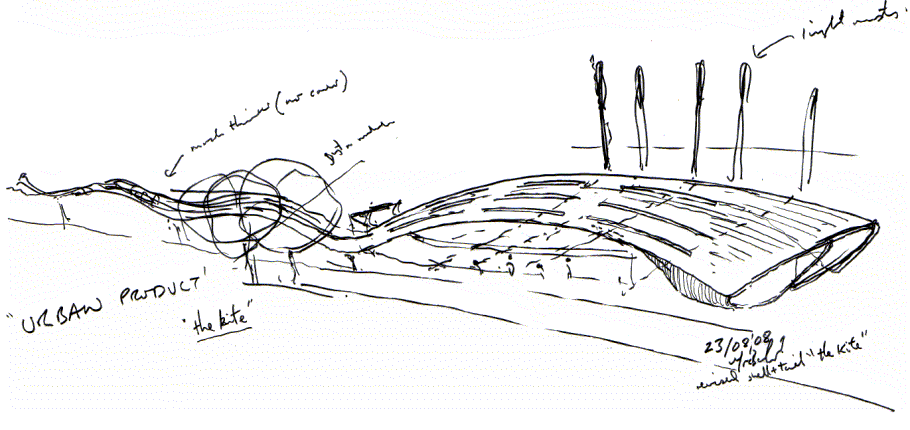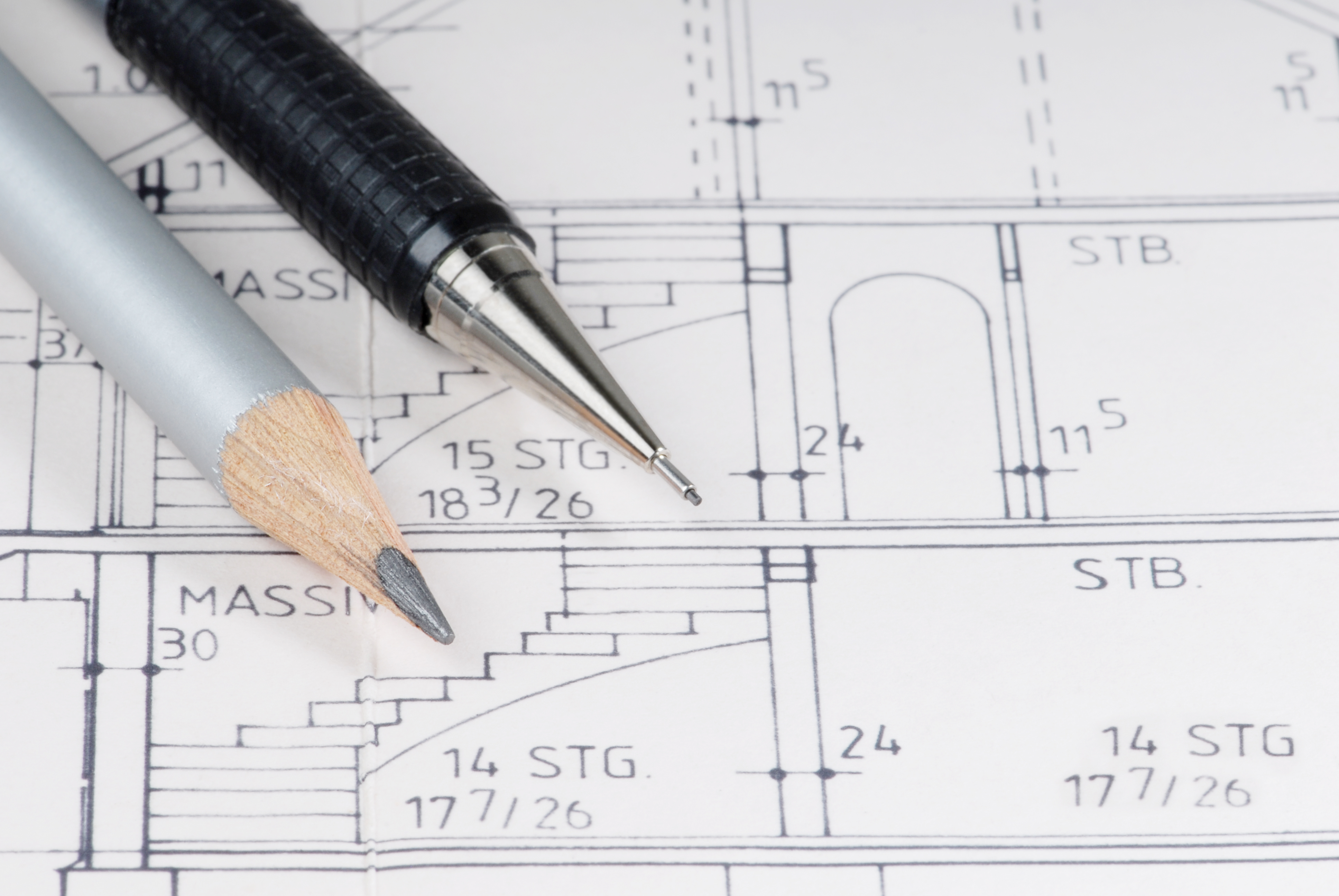Design drawings
Design drawings are used to develop and communicate ideas about a developing design:
In the early stages of the project phase (during the design and tender process) they might simply demonstrate to the client the ability of a particular design team to undertake the design. They may then be used to:
- Develop and communicating the brief.
- Investigate potential sites and assess options.
- Develop the approved idea into a coherent and co-ordinated design.
- Communicate the developed design to other parties, such as the local planning authority, the building control body, contractors and suppliers.
- Record the completed construction.
- Record ongoing changes to the completed construction.
Some of these drawings are not traditionally considered to be ‘design’ drawings, as either the design proper has not begun, or the design has effectively already been completed. However, almost all of them will include some element of an investigation into, or development of the design, or they would serve no purpose.
Very broadly, design drawings are categorised as:
- Feasibility studies.
- Options appraisals.
- Concept drawings. Some designers will differentiate between 'conceptual design' and 'schematic design'. In this case, the 'concept' is the initial design idea, whereas the 'scheme' develops the concept, taking on board more functional and practical considerations.
- Detailed design drawings (or developed design drawings).
- Technical drawings.
- Tender drawings.
- Shop drawings, installation drawings and construction drawings.
Design drawings will develop in detail from block and massing drawings and sketches to very detailed technical drawings describing every component in a way that will enable them to be constructed and operated.
When developing design drawings, it is important to consider what their purpose is, what information they are intended to convey and who they are intended to convey it to. This will determine their format, content, size, scale, and so on. For example, design drawings prepared for an inexperienced client may need to be very clear and to present only necessary information, at a scale and format that the client can easily view and share. Drawings for suppliers, on the other hand, may need to be very detailed and in a format that can be used for fabrication.
Design drawings may be prepared by a number of different practitioners, such as; architects, technicians and technologists, structural engineers, civil engineers, building services engineers, interior designers, landscape designers, contractors, subcontractors, suppliers, and so on. Some elements may first be designed by one individual or organisation and then taken on and developed by another.
It is important therefore that they are carefully integrated and co-ordinated to ensure that all elements are designed to an appropriate level of detail at the right time, and that designs prepared by different members of the project team create a single, unified set of information that can be constructed without clashes between components.
Typically, a lead designer will be appointed whose role includes integrating different aspects of the design and their interfaces into the overall design. Amongst other things, this may involve:
- Ensuring collaborative practices are adopted.
- Coordinating quality control systems.
- Adopting standard methods and procedures.
- Coordinating the preparation and issue of production information to contractors and suppliers.
- Reviewing designs prepared by contractors and suppliers.
Different parts of the design team may also have design managers with an enabling and co-ordinating role.
The preparation of design drawings has been revolutionised by the emergence first of computer aided design (CAD) and then building information modelling (BIM). BIM allows the whole project team to collaborate on the development of a single integrated information model (although at level 2, this model is a ‘federated’ combination of separate models). However, the principle is the same as for traditional design in that the model will begin by communicating design intent, and will develop to become a virtual construction model.
In the early stages, it is likely to include massing diagrams or 2D symbols to represent generic elements of the design, with some critical elements developed in more detail. As the design progresses, the model will develop and the level of detail will increase, including, first, objects based on generic representations, and then specific objects with specifications and method statements attached along with information about space allocation for operation, access, maintenance, installation, replacement, and so on. Ultimately, it will contain all the information necessary to allow the objects in the model to be manufactured, installed or constructed and then operated.
Where BIM differs from traditional drawings is that a great deal of effort is put into defining the level of detail that is required for each element of the design at each stage of its development.
See also Types of drawings for building design for a description of different drawing formats and projections.
[edit] Related articles on Designing Buildings
- As-built drawings and record drawings.
- Assembly drawing.
- Building information modelling.
- Construction drawing.
- Detail drawing.
- Component drawing.
- Concept drawing.
- Design information.
- Design intent.
- Drawings.
- Elevations.
- General arrangement drawing.
- Information manager.
- Installation drawings.
- Lead designer.
- Level of Development LOD.
- North American Paper Sizes.
- Notation and units on drawings and documents.
- Orthogonal plan.
- Paper sizes.
- PAS 1192-2.
- Prefabrication.
- Production information.
- Project information.
- Projections.
- Residential design and 3D rendering.
- Scale drawing.
- Section drawing.
- Shop drawings.
- Space planning.
- Suppliers.
- Symbols on architectural drawings.
- Technical drawing.
- Technical drawing pen sizes.
- Types of drawing.
- Working drawings.
Featured articles and news
Government consultations for the summer of 2025
A year of Labour, past and present consultations on the environment, the built environment, training and tax.
CMA competitiveness probe of major housing developers
100 million affordable housing contributions committed with further consultation published.
Homes England supports Greencore Homes
42 new build affordable sustainable homes in Oxfordshire.
Zero carbon social housing: unlocking brownfield potential
Seven ZEDpod strategies for brownfield housing success.
CIOB report; a blueprint for SDGs and the built environment
Pairing the Sustainable Development Goals with projects.
Types, tests, standards and fires relating to external cladding
Brief descriptions with an extensive list of fires for review.
Latest Build UK Building Safety Regime explainer published
Key elements in one short, now updated document.
UKGBC launch the UK Climate Resilience Roadmap
First guidance of its kind on direct climate impacts for the built environment and how it can adapt.
CLC Health, Safety and Wellbeing Strategy 2025
Launched by the Minister for Industry to look at fatalities on site, improving mental health and other issues.
One of the most impressive Victorian architects. Book review.
Common Assessment Standard now with building safety
New CAS update now includes mandatory building safety questions.
RTPI leader to become new CIOB Chief Executive Officer
Dr Victoria Hills MRTPI, FICE to take over after Caroline Gumble’s departure.
Social and affordable housing, a long term plan for delivery
The “Delivering a Decade of Renewal for Social and Affordable Housing” strategy sets out future path.
A change to adoptive architecture
Effects of global weather warming on architectural detailing, material choice and human interaction.
The proposed publicly owned and backed subsidiary of Homes England, to facilitate new homes.
How big is the problem and what can we do to mitigate the effects?
Overheating guidance and tools for building designers
A number of cool guides to help with the heat.
The UK's Modern Industrial Strategy: A 10 year plan
Previous consultation criticism, current key elements and general support with some persisting reservations.
Building Safety Regulator reforms
New roles, new staff and a new fast track service pave the way for a single construction regulator.


























